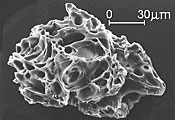Volcanic ash
Volcanic Ash[edit | edit source]
Volcanic ash consists of small fragments of pulverized rock, minerals, and volcanic glass, created during volcanic eruptions. Unlike the soft ash produced by burning wood or other organic materials, volcanic ash is hard, abrasive, and does not dissolve in water.
Formation[edit | edit source]
Volcanic ash is formed during explosive volcanic eruptions when dissolved gases in magma expand and escape violently into the atmosphere. This shattering of magma and surrounding rocks produces fine particles that are carried into the atmosphere by the eruption column.
Composition[edit | edit source]
Volcanic ash is composed of a mixture of minerals, volcanic glass, and rock fragments. The specific composition can vary depending on the type of volcano and the nature of the eruption. Common minerals found in volcanic ash include feldspar, quartz, and pyroxene.
Effects on the Environment[edit | edit source]
Volcanic ash can have significant impacts on the environment. It can cover large areas, affecting vegetation, water supplies, and infrastructure. Ash can also cause respiratory problems for humans and animals.
Impact on Aviation[edit | edit source]
Volcanic ash poses a serious hazard to aviation. Ash clouds can damage aircraft engines, leading to engine failure. The fine particles can also abrade aircraft surfaces and windshields, reducing visibility and safety.
Volcanic Ash and Climate[edit | edit source]
Volcanic ash can influence climate by reflecting sunlight away from the Earth, leading to temporary cooling. Large eruptions can inject ash and sulfur dioxide into the stratosphere, forming aerosols that can persist for years.
Historical Eruptions[edit | edit source]
Some notable historical eruptions that produced significant ash fall include the 1980 eruption of Mount St. Helens, the 1991 eruption of Mount Pinatubo, and the 2010 eruption of Eyjafjallajökull.
Ashfall[edit | edit source]
Ashfall refers to the deposition of volcanic ash from the atmosphere onto the Earth's surface. The thickness and extent of ashfall depend on the size of the eruption and wind patterns.
Cleanup and Mitigation[edit | edit source]
Cleaning up volcanic ash can be challenging due to its abrasive nature and the large volumes that can be deposited. Mitigation strategies include using water to suppress ash and wearing protective gear to prevent inhalation.
Related Pages[edit | edit source]
Search WikiMD
Ad.Tired of being Overweight? Try W8MD's NYC physician weight loss.
Semaglutide (Ozempic / Wegovy and Tirzepatide (Mounjaro / Zepbound) available. Call 718 946 5500.
Advertise on WikiMD
|
WikiMD's Wellness Encyclopedia |
| Let Food Be Thy Medicine Medicine Thy Food - Hippocrates |
Translate this page: - East Asian
中文,
日本,
한국어,
South Asian
हिन्दी,
தமிழ்,
తెలుగు,
Urdu,
ಕನ್ನಡ,
Southeast Asian
Indonesian,
Vietnamese,
Thai,
မြန်မာဘာသာ,
বাংলা
European
español,
Deutsch,
français,
Greek,
português do Brasil,
polski,
română,
русский,
Nederlands,
norsk,
svenska,
suomi,
Italian
Middle Eastern & African
عربى,
Turkish,
Persian,
Hebrew,
Afrikaans,
isiZulu,
Kiswahili,
Other
Bulgarian,
Hungarian,
Czech,
Swedish,
മലയാളം,
मराठी,
ਪੰਜਾਬੀ,
ગુજરાતી,
Portuguese,
Ukrainian
Medical Disclaimer: WikiMD is not a substitute for professional medical advice. The information on WikiMD is provided as an information resource only, may be incorrect, outdated or misleading, and is not to be used or relied on for any diagnostic or treatment purposes. Please consult your health care provider before making any healthcare decisions or for guidance about a specific medical condition. WikiMD expressly disclaims responsibility, and shall have no liability, for any damages, loss, injury, or liability whatsoever suffered as a result of your reliance on the information contained in this site. By visiting this site you agree to the foregoing terms and conditions, which may from time to time be changed or supplemented by WikiMD. If you do not agree to the foregoing terms and conditions, you should not enter or use this site. See full disclaimer.
Credits:Most images are courtesy of Wikimedia commons, and templates, categories Wikipedia, licensed under CC BY SA or similar.
Contributors: Prab R. Tumpati, MD








